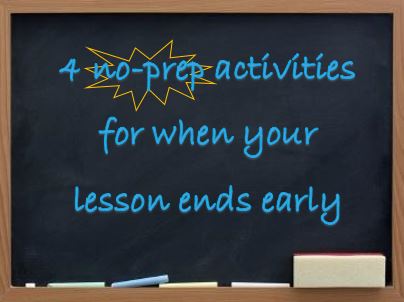 It’s one of those rarities in teaching. You tell the kids to answer questions for a quick pre-test and turn it in – and they do.
It’s one of those rarities in teaching. You tell the kids to answer questions for a quick pre-test and turn it in – and they do.
You go through your lesson – and they listen. You divide them into partners for a closing activity – and they move and work seamlessly. Maybe they are really engaged in the lesson, maybe they are too tired to get distracted, maybe it’s a full moon. But whatever the reason, you now hear a chorus of students saying, “We’re done! Now what?”
Below are a few of my no-prep, go-to activities whenever an entire lesson finishes up early.
1. Vocab Game
Have a student sit in the front of the room (if you have a smartboard, have them sit in front of the Smartboard). Either write a vocabulary word on a sheet of paper and tape it to the wall over their head or type it above them on the Smartboard. They get to call on classmates to give them clues to until they can guess the word. When they get it right, they get to call a new student to go in the hot seat!
Make sure to set up ground rules for what type of clues are acceptable – shut down rhyming and spelling right away
2. Build a Story
 Each student takes out a sheet of paper and writes their name at the top. Then, have the entire class copy down a story starter that you choose. Print out this list of story starters to keep at your desk, or just make one up. One of my standard’s is: “The school day started out like any other, and then…”
Each student takes out a sheet of paper and writes their name at the top. Then, have the entire class copy down a story starter that you choose. Print out this list of story starters to keep at your desk, or just make one up. One of my standard’s is: “The school day started out like any other, and then…”
Give them one minute to continue the story, then make them freeze and pass their story to the person sitting to their left. They have one minute to continue the new story. Continue this until you only have a two minutes or so left in the class, because the kids will want a chance to get their original story back to see how it turned out!
Add a connection to your content by calling out rules for each switch. Example: “Everyone must use a metaphor at some point!” or “Use a prime number some way!”
3. Brain Teasers
One of my college professors used to put a brainteaser on the board for us at the end of class. We were adults, sitting inside on a summer day as we pursued our Master’s degree, and yet as soon as the puzzle was on the board we would all quiet down and begin thinking or scribbling or whatever else it took to get the ideas flowing.
I like to keep using the same puzzle day after day until the students figure it out. When the bell rings and they beg for the answer, just smile that sly teacher-smile and tell them they’ll have to wait. This is a great way to get the entire class trying to work together to solve a problem.
The first puzzle I use is the one my professor used with us, Petals Around a Rose. But here is a list of some other brain teasers that don’t require any printed copies or supplies. Just make sure you solve before giving them to your students!
4. Would You Rather…
 My brother bought me this book over 15 years ago, and it has made its way along road trips, during waits for tickets to be released and finally into my classroom. The concept is a simple one that has been used during parties and midnight sleepover conversations for years: would you rather _____ or ______?
My brother bought me this book over 15 years ago, and it has made its way along road trips, during waits for tickets to be released and finally into my classroom. The concept is a simple one that has been used during parties and midnight sleepover conversations for years: would you rather _____ or ______?
I keep this book at my desk and when we have time left over, I’ll pull it out and call on a student. Sometimes, if the class has already started chatting, I’ll just ask the question in a normal volume to a few kids sitting by my desk. When others hear them discussing the pros and cons of having feet for hands (or some equally bizarre situation) they immediately quiet down and want to chime in.
Encourage critical-thinking and reinforce using evidence to support responses (CCSS 1) by making sure each student who answers supports his/her answer completely. I love “Mind in Bloom’s” blog post on the value of these questions
Leave a comment with what YOU do when your class ends early!
